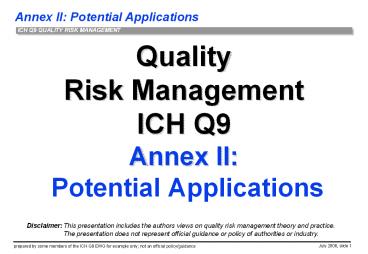Quality Risk Management ICH Q9 Annex II: Potential Applications - PowerPoint PPT Presentation
1 / 18
Title:
Quality Risk Management ICH Q9 Annex II: Potential Applications
Description:
Risk Management ICH Q9 Annex II: Potential Applications Disclaimer: This presentation includes the authors views on quality risk management theory and practice. – PowerPoint PPT presentation
Number of Views:276
Avg rating:3.0/5.0
Title: Quality Risk Management ICH Q9 Annex II: Potential Applications
1
QualityRisk ManagementICH Q9Annex II
Potential Applications
Disclaimer This presentation includes the
authors views on quality risk management theory
and practice. The presentation does not
represent official guidance or policy of
authorities or industry.
2
Purpose of this part
- To guide throughPotential Applications for
Quality Risk Management - Provision of some concrete, non exhaustive
examples
3
Introduction
- This Annex is intended to identify potential uses
of quality risk management principles and tools
by industry and regulators. - However, the selection of particular risk
management tools is completely dependent upon
specific facts and circumstances. - These examples are provided for illustrative
purposes and only suggest potential uses of
quality risk management. - This Annex is not intended to create any new
expectations beyond the current regulatory
requirements.
ICH Q9
4
Potential Applications for Quality Risk Management
- Quality Risk Management as Part of
- II.1 Integrated Quality Management
- II.2 Regulatory Operations
- II.3 Development
- II.4 Facilities, Equipment and Utilities
- II.5 Materials Management
- II.6 Production
- II.7 Laboratory Control and Stability Studies
- II.8 Packaging and Labelling
5
Quality risk management
Communicationfacilitates trust and understanding
Industryoperation - Submissions - Manufacturing
Regulatorsoperation- Reviews - Inspections
6
Quality Risk Management
is not a single process
Start
Process-step
Decision
Feedback procedure
Sub-process
Sub-Sub-process
End
7
Probability and Severity
- Given the broad concept of risk can probability
and severity be more narrowly defined? - Probability has two major meanings
- Frequency of successes divided by the number of
trials - Degree of belief
- Severity is even more difficult to qualify as it
often has different variable attributes around a
quantifiable outcome - Examples
G. Claycamb, FDA, Sept. 2005
8
Which consequence is more severe?
- 300 lives lost in single, fiery plane crash
- 300 lives lost on country roads over a weekend
- 300 lives potentially lost from cancer within the
next 20 years - Even in a narrow context, e.g., microbial
contamination, severity potentially spans - Product spoilage
- Mild malaiseacute illness(acute) death
- Chronic illnesspremature death
G. Claycamb, FDA, Sept. 2005
9
Simple Probability Statements?
- A common understanding of probability is elusive!
- For example
- What does a 30 chance of rain tomorrow mean?
- 30 of the days like tomorrow will have at least
a trace of rain. - 30 of the area will have rain tomorrow.
- 30 of the time tomorrow, it will rain.
- See Gigerenzer, et. al (2005)
G. Claycamb, FDA, Sept. 2005
10
Challenges for potential applications
- ProblemWhat is the risk of a rain shower now?
- Answer 1
- Set up a new department with 5 employees
- Develop a computer program for this risk
(weather forecast) - 10 external meetings, 2 conferences, 5
publications, - Verify with experimental data
- Revisit your program on an annual basis
- Answer 2
- Look out of a window
S. Rönninger, Sept. 2005
11
Managing risks in a company
ICH Q9
12
Existing organisation
13
Risk Management Strategy for Excipients
Development
Manufacturing
Launch
Surveillance
Estimate risk vs hazard Confirm acceptability Implement protective measures Implement surveillance measures
Characterize materials Define specs/quality system practices Create literature/define surveillance criteria Monitor issues and assess root causes
Conduct hazard exposure assessment Define process controls Monitor process controls Re-assess effectiveness of process controls
Develop risk mitigation strategy Confirm risk mitigation strategy Implement risk mitigation strategy Re-assess effectiveness of Risk mitigation
Define risk control measure (s) Select risk control measure (s) Implement risk control measure (s) Re-assess effectiveness of Risk control measure(s)
Evaluate results and make appropriate course
corrections based on regulations, customer
expectation, company policies and procedures,
societal trends and needs
Patricia Rafidison, Dow Corning Life Sciences
IPEC Europe, June 2005
14
Quality risk management as part of
- Conclusion
15
Using ICH Q9 will
- Facilitate
- Communication and transparency
- More informed, scientifically based decision
making - Patient focused actions on quality risks
- Realistic and appropriate solutions
- Use of existing solutions (Share best
practice/prior knowledge) - Manage critical to quality aspects
- Through systems, organisations, processes
products - Maintain responsibility accountability for QRM
- Focus activity towards patient protection
- It should never be used as a hobby horse /
preconceived idea
16
Opportunity for the Industry Competent
Authorities
- Using the same guideline apply QRM to industry
(Development Manufacture) and regulators
(Reviewer Inspectorate) - Provides for establishing a defined program for
what we already do every day in our jobs - Supports science-based decision making
- Optimisation of resources
- Prevention from overly restrictive and
unnecessary requirements - Facilitates communication and transparency
17
Challenges for Industry Competent Authorities
- Interpreting and adopting the concepts of
quality risk management into specific areas - Embed this behavior into quality aspects of
business, technology and regulation - Adopt in existing structures, organizations and
Quality System - Balance the documented use of informal and
formal quality risk management
18
- Integration of QRM into existing systems and
regulatory processes will require a development
of trust over time































